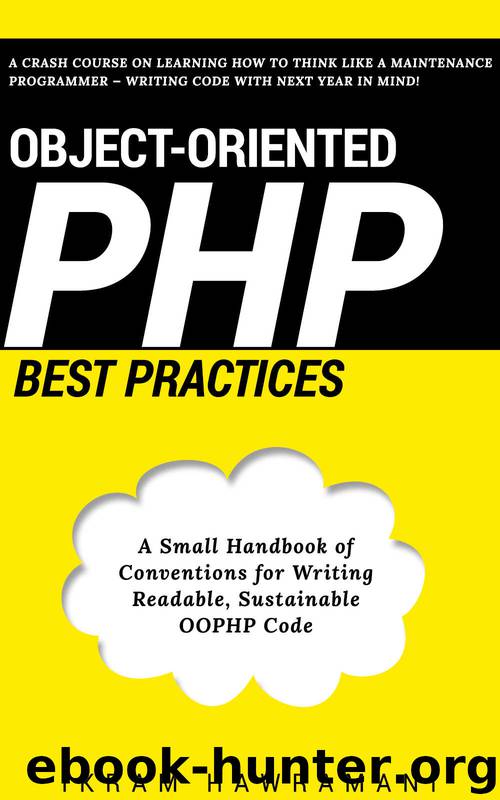Object-Oriented PHP Best Practices: A Small Handbook of Conventions for Writing Readable, Sustainable OOPHP Code by Ikram Hawramani

Author:Ikram Hawramani [Hawramani, Ikram]
Language: eng
Format: azw3
Publisher: Hawramani.com
Published: 2017-03-24T04:00:00+00:00
$school_name = $school->getName();
// and so on
}
?>
Now, the School object is being instantiated only once per school, and then reused for each student that belongs to that particular school. This means that a maximum of only 10 school objects will be created throughout the loop’s lifetime (since there are only 10 schools in the district as described earlier).
The problem with this method is that my team decided it was too much of an annoyance to implement a separate cache for each class. There had to be a better way.
After months of thinking, during a caffeine and phenylpiracetam fueled 15-minutes of clarity, I wrote the following class:
<?php
class Repository {
private static $repository = [];
Download
This site does not store any files on its server. We only index and link to content provided by other sites. Please contact the content providers to delete copyright contents if any and email us, we'll remove relevant links or contents immediately.
Hello! Python by Anthony Briggs(10120)
The Mikado Method by Ola Ellnestam Daniel Brolund(10011)
Dependency Injection in .NET by Mark Seemann(9515)
Sass and Compass in Action by Wynn Netherland Nathan Weizenbaum Chris Eppstein Brandon Mathis(7915)
Svelte with Test-Driven Development by Daniel Irvine(7796)
The Well-Grounded Java Developer by Benjamin J. Evans Martijn Verburg(7768)
Test-Driven Development with PHP 8 by Rainier Sarabia(7534)
Layered Design for Ruby on Rails Applications by Dementyev Vladimir;(7365)
Web Development with Django by Ben Shaw Saurabh Badhwar(6870)
Secrets of the JavaScript Ninja by John Resig Bear Bibeault(6633)
Secrets of the JavaScript Ninja by John Resig & Bear Bibeault(6631)
React Application Architecture for Production by Alan Alickovic(6552)
Jquery UI in Action : Master the concepts Of Jquery UI: A Step By Step Approach by ANMOL GOYAL(5872)
Kotlin in Action by Dmitry Jemerov(5296)
Software Architecture for Web Developers by Mihaela Roxana Ghidersa(4790)
Audition by Ryu Murakami(4765)
Accelerating Server-Side Development with Fastify by Manuel Spigolon Maksim Sinik & Matteo Collina(4635)
Hands-On Full-Stack Web Development with GraphQL and React by Sebastian Grebe(4382)
Solidity Programming Essentials by Ritesh Modi(4363)
